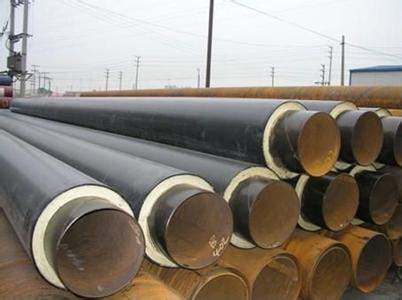保溫管集中供熱系統(tǒng)中熱力失調(diào)問題就要詳細(xì)問題詳細(xì)剖析。普通狀況下,關(guān)于溫度失調(diào),經(jīng)過檢查肯定緣由之后,能夠選擇優(yōu)化熱源設(shè)備,保證熱源供熱充足,或者改換用戶換熱器,提升換熱器的換熱效率,都能夠很好地處理溫度失調(diào)的問題。
Thermodynamic imbalance in heat-insulating pipe central heating system should be analyzed in detail. Under normal conditions, the problem of temperature imbalance can be well handled by choosing optimal heat source equipment, ensuring adequate heat supply, or changing user heat exchangers to improve the heat exchange efficiency of heat exchangers after checking and confirming the reasons.
保溫管集中供熱系統(tǒng)的水力失調(diào)問題的處理方法愈加普遍、多樣,詳細(xì)包括:
Hydraulic imbalance of heat preservation pipe central heating system is becoming more and more common and diverse, including:
①調(diào)理閥的運(yùn)用。運(yùn)用調(diào)理閥是緩解集中供熱系統(tǒng)熱力失調(diào),保證水力均衡的一個(gè)重要措施。保溫管網(wǎng)中運(yùn)用的調(diào)理閥主要有靜態(tài)調(diào)理閥、動(dòng)態(tài)流量均衡閥和動(dòng)態(tài)壓差均衡閥三種主要類型。
The application of conditioning valve. The use of conditioning valve is an important measure to alleviate the thermal imbalance of central heating system and ensure the hydraulic balance. There are three main types of regulating valves used in heat preservation pipeline network: static regulating valves, dynamic flow equalizing valves and dynamic differential pressure equalizing valves.
詳細(xì)來說,靜態(tài)調(diào)理閥在水力均衡中起著根底性的調(diào)理作用,其工作原理是經(jīng)過對(duì)管道內(nèi)阻力的調(diào)理,到達(dá)對(duì)孔板調(diào)理的目的,進(jìn)而均衡保溫管管網(wǎng)中的阻力,因而,靜態(tài)調(diào)理閥是人工調(diào)理操作的
In detail, the static conditioning valve plays a fundamental role in hydraulic balancing. Its working principle is to adjust the resistance in the pipeline to reach the purpose of orifice plate conditioning, and then balance the resistance in the insulation pipe network. Therefore, the static conditioning valve is an artificial conditioning operation.
動(dòng)態(tài)流量均衡閥也叫自力式流量控制閥,是完成管網(wǎng)的水力均衡的重要設(shè)備。詳細(xì)的工作原理是,依據(jù)閥門的前后壓的不同,對(duì)閥門停止自動(dòng)開大或開小,保證對(duì)流量的恒定,到達(dá)對(duì)流量的合理控制。恒流量調(diào)理閥是一種新型的動(dòng)態(tài)流量調(diào)控設(shè)備,能夠完成各環(huán)路流量的自主調(diào)理,保證熱力管網(wǎng)的水力均衡。相比于原有的調(diào)理閥需求人力操作,恒流量調(diào)理閥的一切系列都可以裝置電動(dòng)執(zhí)行器,并且銜接到熱力管網(wǎng)的自動(dòng)控制系統(tǒng)中,完成供熱系統(tǒng)的自動(dòng)化控制。相較于原來的人力調(diào)理閥,恒流量調(diào)理閥的操作愈加便當(dāng)快捷、簡單智能,并且裝置本錢并不高。
Dynamic flow equalization valve, also known as self-operated flow control valve, is an important equipment to complete the hydraulic equalization of the pipeline network. Detailed working principle is that according to the different pressures of the front and back of the valve, the valve stops automatically opening large or small to ensure that the flow is constant and the flow is controlled reasonably. Constant flow conditioning valve is a new type of dynamic flow control equipment, which can complete the flow self-regulation of each loop and ensure the hydraulic balance of the thermal pipe network. Compared with the original conditioning valves, all series of constant flow conditioning valves can be equipped with electric actuators, and connected to the automatic control system of the heating network to complete the automatic control of the heating system. Compared with the original manual control valve, the constant flow control valve is more convenient, simple and intelligent, and the cost of the device is not high.
動(dòng)態(tài)壓差均衡閥,也叫作自力式均衡閥,是一種經(jīng)過對(duì)壓差的丈量和調(diào)試,為熱力管網(wǎng)調(diào)理提供數(shù)據(jù)參考的系統(tǒng),詳細(xì)的工作原理是,當(dāng)保溫管道內(nèi)流量產(chǎn)生變化時(shí),自力閥的閥芯會(huì)隨之上下挪動(dòng),這樣一來,自力閥的流量面積和流量系數(shù)會(huì)變得不同,但是在不同位置上也會(huì)一直保證閥芯和閥座完成均衡,保證差壓值堅(jiān)持不變。通常狀況下,動(dòng)態(tài)壓差均衡閥要在每一個(gè)控制節(jié)點(diǎn)都停止裝置,從而完成關(guān)于熱力管網(wǎng)的整體監(jiān)測

Dynamic pressure differential equalization valve, also known as self-balancing valve, is a kind of system which provides data reference for the regulation of thermal pipe network after measuring and debugging the pressure difference. The detailed working principle is that when the flow rate in the insulation pipe changes, the valve core of self-balancing valve will move up and down accordingly. Thus, the flow surface of self-balancing valve will be moved up and down. The cumulative flow coefficient will be different, but at different locations it will always ensure that the spool and seat are balanced and that the differential pressure value remains unchanged. In general, the dynamic differential pressure equalization valve should stop the device at each control node to complete the overall monitoring of the thermal network.
②加壓泵的運(yùn)用。運(yùn)用加壓泵主要是指在供熱不利端裝置加壓泵加壓泵的運(yùn)用是處理熱力管網(wǎng)水利失調(diào),保證水力均衡的又一重要措施。這是由于供熱系統(tǒng)循環(huán)水泵實(shí)踐揚(yáng)程和流量并不是固定不變且一直堅(jiān)持充足的狀態(tài),因而在實(shí)踐運(yùn)轉(zhuǎn)中,就會(huì)呈現(xiàn)保溫管熱網(wǎng)中循環(huán)水泵實(shí)踐揚(yáng)程和流量不夠的狀況,這就勢必會(huì)形成遠(yuǎn)處供熱不利端的資用壓頭或流量缺乏。所以,在供熱不利端用戶的換熱站內(nèi)加裝水泵,就有助于保證不利端用戶供熱流量。
(2) Application of pressure pump. The use of pressurized pumps mainly refers to the use of pressurized pumps at the disadvantageous end of heating, which is another important measure to deal with the hydraulic imbalance of the thermal pipe network and ensure the hydraulic balance. This is because the practice head and flow of circulating water pump in heating system are not fixed and have been adhering to sufficient conditions, so in practice, there will be insufficient practice head and flow of circulating water pump in heat insulation pipe network, which will inevitably lead to the lack of capital pressure head or flow at the disadvantageous end of distant heating. Therefore, installing water pumps in heat exchanger stations of unfavorable end users will help to ensure the heating flow of unfavorable end users.
需求留意的是,在換熱站內(nèi)加裝水泵,必需要慎重選擇、合理裝置,防止影響周邊其他用戶的流量,形成更嚴(yán)重的水力失調(diào),如“搶水”問題等。選擇水泵,一方面要理解換熱站內(nèi)已知的參數(shù),另一方面要理解所需的詳細(xì)資用壓頭和流量,二者分離作為選擇水泵的參考規(guī)范。通常狀況下小型加壓水泵已足夠滿足大多數(shù)用戶的需求。目前水泵的類型豐厚多樣、技術(shù)成熟,有小流量、小揚(yáng)程、低噪音、免維護(hù)水泵,還有技術(shù)含量更高的三擋變速水泵、帶變頻的可自動(dòng)調(diào)理(流量、溫度、壓力、壓差)的無級(jí)變速水泵。
It should be noted that the installation of pumps in heat exchanger stations should be carefully selected and reasonably equipped to prevent the flow rate affecting other users around them from forming more serious hydraulic imbalances, such as "water grabbing" problems. To select pumps, one needs to understand the known parameters in the heat exchanger station, and the other needs to understand the detailed information of pressure head and flow. Separation of the two is used as a reference criterion for selecting pumps. Usually, small pressurized pumps are enough to meet the needs of most users. At present, the types of pumps are rich and varied, and the technology is mature. There are small flow, small lift, low noise, maintenance-free pumps, and three-speed variable-speed pumps with higher technical content, and continuously variable-speed pumps with frequency conversion (flow, temperature, pressure, differential pressure).
③供熱系統(tǒng)設(shè)備的優(yōu)化。供熱系統(tǒng)設(shè)備的優(yōu)化,主要是關(guān)于老化、不合格、不合理管道,供熱效率低的鍋爐和熱能轉(zhuǎn)化率低的換熱器等設(shè)備停止優(yōu)化改造,進(jìn)步保溫管集中供熱系統(tǒng)的熱量,減少熱量保送中的喪失和損耗,進(jìn)步二次熱能的轉(zhuǎn)化率,減少熱力失調(diào)現(xiàn)象的呈現(xiàn)。
(3) The optimization of heating system equipment. The optimization of heating system equipment is mainly concerned with aging, unqualified and unreasonable pipes, boilers with low heating efficiency and heat exchangers with low heat energy conversion rate, etc. to stop the optimization and transformation, to improve the heat of heat preservation pipe central heating system, to reduce the loss and loss in heat storage, to improve the conversion rate of secondary heat energy and to reduce it. Presentation of thermodynamic imbalance.







